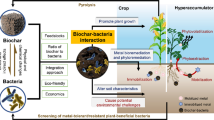Abstract
Purpose
Methane biofiltration is based on gas transformation to carbon dioxide and water by methanotrophic microorganisms. Biofilter performance has been thoroughly investigated under climatic conditions of Western Europe, but not those of Russia. Therefore, this study was conducted to analyze methane biotransformation performance of soil and soil-like biofilters in Moscow.
Materials and methods
Biofilters were designed as three-layer systems (0.2 × 0.2 × 0.5 m) where methane (2.5 vol%) was injected daily. This system operated for 9 months. Five biofilters with different working layers have been investigated: a natural humic horizon of albeluvisol (AB); two soil-like types of media containing peat (PB) or compost (CB) as organic matter; and two soil-like types of media containing the reclamation additives vermiculite (CVB) and clayite (CCB). Methane and carbon dioxide were measured in hermetically covered biofilters immediately and 24 h after methane injection. These gases were collected through a six-tube system incorporated into the biofilters and analyzed by gas chromatography.
Results and discussion
The maximum methane biotransformation occurred in summer, while there was slightly less in autumn and much less in winter. The highest values of 99.7, 97.0, and 91.5 % were observed in AB, followed by 97.8, 92.4, and 72.8 % in CB and 52.6, 43.2, and 23.8 % in PB during summer, autumn, and winter, respectively. Methane biotransformation rates were correlated with methanotroph pools in biofilter media. Summer carbon dioxide levels were lowest in AB (0.7 %) and highest in CB (2.6 %) due to difference in organic composition and its mineralization rates. Emission levels were highest in AB (0.2 %) driven by the maximum porosity of this media providing gas transport to the atmosphere; CVB had the lowest carbon dioxide emission (0.02 %) due to incorporation of sorptive additive. Carbon dioxide generation generally stopped during winter, while increasing acidity was observed in summer and autumn because of the formation of carbonic acid, and redox potential increased significantly in winter due to carbon dioxide elimination.
Conclusions
Under Moscow’s climatic conditions, biofilters can perform efficiently during summer and autumn, but methane biotransformation is much lower during winter. CVB showed the greatest potential for use under these conditions owing to its high methane biotransformation and low carbon dioxide emissions.







Similar content being viewed by others
References
Bingemer HG, Crutzen PJ (1987) The production of methane from solid wastes. J Geophys Res 92(D2):2181–2187
Dedysh SN, Panikov NS (1997) Methane concentration influence on the rate of its bacterial oxidation in sphagnum peat. Microbiology 66(4):563–568
Galchenko VF (2001) Methanotrophic bacteria. GEOS, Moscow
Hanson RS, Hanson TE (1996) Methanotrophic bacteria. Microbiol Rev 60(2):439–471
Hettiarachchi V, Mehrotra A, Kumar S (2011) Field-scale operation of methane biofiltration systems to mitigate point source methane emissions. Environ Pollut 159(6):1715–1720
IPCC (2007) 4th Assessment. Rep. Chap. 2: changes in atmospheric constituents and radiative forcing. Geneva
Leson G, Winer AM (1991) Biofiltration: an innovative air pollution control technology for VOC emission. J Air Waste Manage Assoc 41(8):1045–1054
Liu Y, Yang M, Wu Y, Wang H, Chen Y, Wu W (2011) Reducing CH4 and CO2 emissions from waterlogged paddy soil with biochar. J Soils Sediments 11:930–939
Nikiema J, Bibeau L, Lavoie J, Brzezinski R, Vigneux J, Heitz M (2005) Biofiltration of methane: an experimental study. Chem Eng J 113(2–3):111–117
Nozhevnikova AN, Lifshitz AB, Lebedev VS, Zavarzin GA (1993) Emission of methane into the atmosphere from landfills in the former USSR. Chemosphere 26(l-4):401–417
Raich J, Potter C (1995) Global patterns of carbon dioxide emissions from soils. Glob Biogeochem Cycle 9(1):23–36
Smith K, Ball T, Conen F, Dobbie K, Massheder J, Rey A (2003) Exchange of greenhouse gases between soil and atmosphere: interactions of soil physical factors and biological processes. Eur J Soil Sci 54:779–791
Streese J, Stegmann R (2003) Microbial oxidation of methane from old landfills in biofilters. Waste Manag 23(7):573–580
Teh YA, Silver WL (2006) Effects of soil structure destruction on methane production and carbon partitioning between methanogenic pathways in tropical rain forest soils. J Geophys Res 111, G01003. doi:10.1029/2005JG000020
Vadyunina AF, Korchagina ZA (1986) Methods of soil physical properties research. Agropromizdat, Moscow
Venugopal S, Chandrakanthi M, Hettiaratchi JPA (2003) Field scale application of methanotrophic biofilters (MBFs) in treating low-volume methane (CH4) emissions from oil and gas Industry. Third International Methane & Nitrous Oxide Mitigation Conference. Beijing, p 854–861
Whalen SC, Reeburgh WS, Sandbeck KA (1990) Rapid methane oxidation in a landfill cover soils. Appl Environ Microbiol 56(11):3405–3411
Whittenbury R, Phillips KC, Wilkinson JF (1970) Enrichment, isolation and some properties of methane-utilizing bacteria. J Gen Microbiol 61(2):205–218
Acknowledgments
This study was supported by the Russian Foundation for Basic Research, project number 12-04-00435 and 14-05-31284.
Author information
Authors and Affiliations
Corresponding author
Additional information
Responsible editor: Richard K. Shaw
Rights and permissions
About this article
Cite this article
Lisovitskaya, O., Lebed-Sharlevich, I., Mozharova, N. et al. Efficiency of methane biotransformation of soil and soil-like biofilters in Moscow. J Soils Sediments 15, 1764–1770 (2015). https://doi.org/10.1007/s11368-014-0965-6
Received:
Accepted:
Published:
Issue Date:
DOI: https://doi.org/10.1007/s11368-014-0965-6




